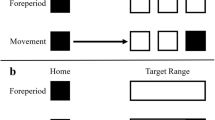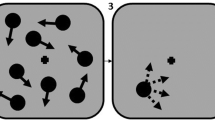Abstract
Current models for targeted-tracking are discussed and shown to be inadequate as a means of understanding the combined task of tracking, as in the Drury’s paradigm, and having a final target to be aimed at, as in the Fitts’ paradigm. It is shown that the task has to be split into components that are, in general, performed sequentially and have a movement time component dependent on the difficulty of the individual component of the task. In some cases, the task time may be controlled by the Fitts’ task difficulty, and in others, it may be dominated by the Drury’s task difficulty. Based on an experiment carried out that captured movement time in combinations of visually controlled and ballistic movements, a model for movement time in targeted-tracking was developed.









Similar content being viewed by others
References
Accot J, Zhai S (1997) Beyond Fitts’ law: models for trajectory-based HCI tasks. In: CHI 1997, proceedings of ACM conference on human factors in computing systems, pp 295–302. doi:10.1145/258549.258760
Blinch J, Cameron BD, Hodges NJ, Chua R (2012) Do preparation or control processes result in the modulation to Fitts’ law for movements to targets with placeholders? Exp Brain Res 223:505–515. doi:10.1007/s00221-012-3277-3
Bollen KA, Jackman RW (1990) Regression diagnostics: an expository treatment of outliers and influential cases. In: Fox J, Long JS (eds) Modern methods of data analysis. Sage, Newbury Park, pp 257–291
Dennerlein JT, Martin DB, Hasser C (2000) Force-feedback improves performance for steering and combined steering-targeting tasks. In: CHI 2000, proceedings SIGCHI conference on human factors in computing systems, The Hague, The Netherlands, pp 423–429. doi:10.1145/332040.332469
Drury C (1971) Movements with lateral constraint. Ergonomics 14:293–305. doi:10.1080/00140137108931246
Fitts P (1954) The information capacity of the human motor system in controlling the amplitude of movement. J Exp Psychol 47:381–391
Fitts PM, Peterson JR (1964) Information capacity of discrete motor responses. J Exp Psychol 67:103–112
Gan K-C, Hoffmann ER (1988) Geometrical conditions for ballistic and visually-controlled movements. Ergonomics 31:829–839. doi:10.1080/00140138808966724
Hick WE (1952) On the rate of gain of information. J Exp Psychol 4:11–26. doi:10.1080/17470215208416600
Hoffmann ER (1981) An ergonomic approach to predetermined motion time systems. In: Proceedings of the 9th national conference, Institute of Industrial Engineers, Australia. Singapore, pp 30–47
Hoffmann ER (2009) Review of models for restricted-path movements. Int J Ind Ergonom 39:578–589. doi:10.1016/j.ergon.2008.02.007
Hoffmann ER (2013) Which version/variation of Fitts’ law? A critique of information-theory models. J Motor Behav 45:205–215. doi:10.1080/00222895.2013.778815
Hoffmann ER, Lim JTA (1997) Concurrent manual-decision tasks. Ergonomics 40:293–318. doi:10.1080/001401397188161
Hong S-K, Ryu S (2007) Human performance model for combined steering-targeting tasks. In: EPCE’07, proceedings of the 7th international conference on engineering psychology and cognitive ergonomics, pp 306–315
Jax SA, Roosenbaum DA, Vaughan J (2007) Extending Fitts’ Law to manual obstacle avoidance. Exp Brain Res 180:775–779. doi:10.1007/s00221-007-0996-y
Johnson RA, Wichern DW (2007) Applied multivariate statistical analysis, 4th edn. Pearson Prentice Hall, New Jersey, pp 187–191
Kulikov S, Stuerzlinger W (2006) Targeted steering motions. In: CHI EA ‘06 CHI ‘06, extended abstracts on human factors in computing systems, Montreal, Canada. doi:10.1145/1125451.1125640
Kvalseth TO (1973) Fitts’ law for manipulative temporal motor responses with and without path constraints. Percept Mot Skills 37:427–431
Kvalseth TO (1975) Note on Fitts’ law for manipulative temporal motor responses with path constraints. Percept Mot Skills 40:411–414
Kvalseth TO (1977) A generalised model of temporal motor control subject to movement constraints. Ergonomics 20:41–50
Kvalseth TO (1978) Quantitative models of motor responses subject to longitudinal, lateral and preview constraints. Hum Factors 20:35–39
Leong CKW, Hoffmann ER, Good MC (2011) Ballistic movements on data-entry keypads. Int J Ind Ergonom 41:180–190. doi:10.1016/j.ergon.2011.01.004
Macuga KL, Papailiou AP, Frey SH (2012) Motor imagery of tool use: relationship to actual use and adherence to Fitts’ law across tasks. Exp Brain Res 218:169–179. doi:10.1007/s00221-012-3004-0
Meyer DE, Abrams RA, Kornblum S, Wright CE, Smith JEK (1988) Optimality in human motor performance: ideal control of rapid aimed movements. Psychol Rev 95:340–370. doi:10.1037/0033-295X.95.3.340
Thibbotuwawa N, Hoffmann ER, Goonetilleke RS (2012) Open-loop and feedback-controlled mouse cursor movements in linear paths. Ergonomics 55:476–488. doi:10.1080/00140139.2011.644587
Vaughan J, Barany DA, Sali AW, Jax SA, Rosenbaum DA (2010) Extending Fitts’ Law to three-dimensional obstacle-avoidance movements: support for the posture-based motion planning model. Exp Brain Res 207:133–138. doi:10.1007/s00221-010-2431-z
Vaughan J, Barany DA, Rios T (2012) The cost of moving with the left hand. Exp Brain Res 220:11–22
Author information
Authors and Affiliations
Corresponding author
Rights and permissions
About this article
Cite this article
Senanayake, R., Hoffmann, E.R. & Goonetilleke, R.S. A model for combined targeting and tracking tasks in computer applications. Exp Brain Res 231, 367–379 (2013). https://doi.org/10.1007/s00221-013-3700-4
Received:
Accepted:
Published:
Issue Date:
DOI: https://doi.org/10.1007/s00221-013-3700-4




